Hello m' sunnies! Please bring tea and sunglasses....
The dry stone hedgerows bob with happy yellow heads. The roadside fields are brazen. Sometimes a distant golden patch shimmers like a mirage, appears to move around and is impossible to locate. The flower picker trucks, with their 'pickers wanted' signs, hold you up your way to and from Rosudgeon carboot sale, grrrrr.
We're talking daffodils.
These particular rows are not for picking - oh no - these bulbs are busy multiplying. Please, let them concentrate...
Scamp's daffodil field, Falmouth, Cornwall
All the pictures on today's post were taken one glorious sunny Sunday
morning (27th March): a trip to Scamp's 14 acre daffodil field on the outskirts
of Falmouth. Many thanks to the super helpful Adrian (Scamp Junior) for welcoming us, and the fab Mylor Garden Club for organising.


In Britain, we can apparently thank the Romans for bringing the daffodil
over. (Monty Python: What have the Romans ever done for us?) The Romans didn't bother too much with this remote Cornish
peninsula though. As long as the tin flowed, the beardy druids were left
in peace to sip their honey mead.
Who knows when the wild daffodil seed rode the 50-year storm wave, or the springy sun ruffled bulb, geared up with sweat bands, pole-vaulted over the Tamar River and made its home in the warm, wet micro climate of the Cornish Riviera?
Narcissus poeticus praecox
William Trevellick was a humble potato farmer on the Isles of Scilly when he spotted a semi-wild narcissi in bloom one January in 1875 and thought 'hmmm - I'll pack some bunches off on the mainland train to London, those Landan town hipsters are bound to go crazy for these early cut flowers'.
By the early 1900s the daffodil 'gold rush' was on. Market farms sprang up by Mounts Bay (Penzance) still known today as 'the golden mile' and on the southern slopes of the Tamar Valley. It was on his uncle's farm (Dan du Plessis) in the Tamar Valley where the young Ron (now Scamp Senior), cut his teeth picking daffodils as a lad in the 1940s and 50s.
Narcissus 'Feock' - isn't she an absolute beaute!?
Above: Narcissus 'Boslowick', another local stunner
Above: Narcissus 'Capability Brown'
The breeder Percival Dacres Williams (1865 - 1935) lived in St Keverene by the Lizard and named many cultivars after Cornish villages and Celtic Saints.
The horticulturist Alec Grey (1895 - 1986) worked on the Scilly Isles and later had a nursery at Treswithian (Camborne way) where he specialised in breeding miniature daffodils. It is quite funny to find out that he was at first unimpressed with his 'Tête-à-Tête' variety (registered in 1949)- one of the biggest sellers of all time.
Plus let's not forget Cornwall's current day 'Daffodil Godfather', or should we say 'Goldfather'- Ron Scamp of Falmouth, who has bred many of his own varieties. Together with son Adrian, the Scamps have won countless Royal Horticulture Society gold medals. Surely they must have lost count by now!?
When Adrian was asked what his favourite daffodil was, he joked whichever one made him the most money! He did then reel off a long list, and this lovely one was on it - the historical variety 'Firebrand' (pre- dating 1897). It is Adrian's hope that the family continue to grow their historic collection, through correctly identifying those found in hedgerows, old gardens and churchyards, plus bulking up the number of their confirmed varieties.
Narcissus 'Firebrand'
Another historical variety captured on camera - 'Compressus' (pre-1719)
Narcissus 'Compressus'
Get your wellies farmer girls and boys! Some notes on the practicalities of the farm now ... The varieties are planted in rows, in batches, in alphabetical order - all clearly marked with wooden battens. The daffodils are not deadheaded - this would take too long.
The filed is split into two zones - the bulbs in the upper part will be lifted this summer. Specialised machinery scoops them out of the ground and deposits them on top of the soil. Seasonal workers, in the form of local students, are then brought in to help collect the bulbs. They are taken to the barn, graded according to size and sterilized with hot water treatment. They are then bagged up for sale or replanted, depending on their plumpness / size.
Above: The edge of this year's bulb harvest - in the distance 'orphans' can be seen in the field now planted with a cereal crop. These are strays that escaped last summer's extraction process.
Above: Lower end of field (Zone 2) - these will be left for another year to plump up.
All Scamp's bulbs are increased through natural multiplication in the ground. Adrian marveled at some of the Dutch growers that come over, take bulbs and very quickly increase stock through the methods of chipping or '
twin scaling'. Anyone who has ever driven through the flat farm lands of Holland can probably appreciate the vast scale of production involved here.
Below: Upper field (Zone 1), with more mature plants and bigger bulbs.
As part of the leased farmland rotation, next year's bulbs will be planted in land where potatoes are currently growing. Adrian explained it's not ideal to follow potatoes with daffodils due to the risk of Potato Cyst Nematodes (nematodes feed on roots and reduce plant vigour). However, luckily it is not something that has ever affected this area, plus there are regular PCN surveys made by outside contractors to monitor the soil and crop quality.
Some important lessons I took away from my visit
- More daffodils will be required at Long Mizzle. Nothing eats them (they are toxic!), bar those annoying tiny slugs that may have a little nibble on the emerging petals. Ratty will leave them alone, unlike tulips that are quite a delicacy. Plus, unlike many tulips, they reliably come back year after year.
- Daffodil 'blindness' (all foliage, no flowers) is more likely to be due to bulbs being planting too shallowly than too deeply. On reflection, the ground under my Trachycarpus Palm was not the best place to have planted some - too dry, stony and rooty to get the required depth!!!They will be moved to pastures new.
- Whilst it is generally recommended to deadhead spent flower heads, to allow the energy to go back into the bulb, the wild ones are to be left alone. For example, I was foolish to deadhead my Narcissus bulbocodium (Hoop peticoats) - which spread via seed.
Above: Scamp's stand at this year's Falmouth Spring Flower Show 2022
(See related post here)
I hope you enjoyed the daffodil field as much as I did.
Please send gossip,
Lulu xXx
P.S. Please note, I am not sponsored in any way, but as a Scamp's customer of many years, I can genuinely recommend them for top quality bulbs, advise and all round super service -
R & A Scamp - Quality Daffodils

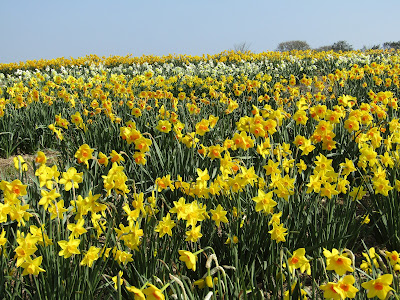













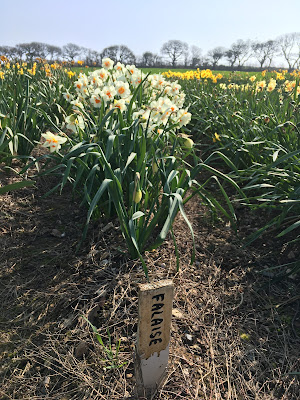






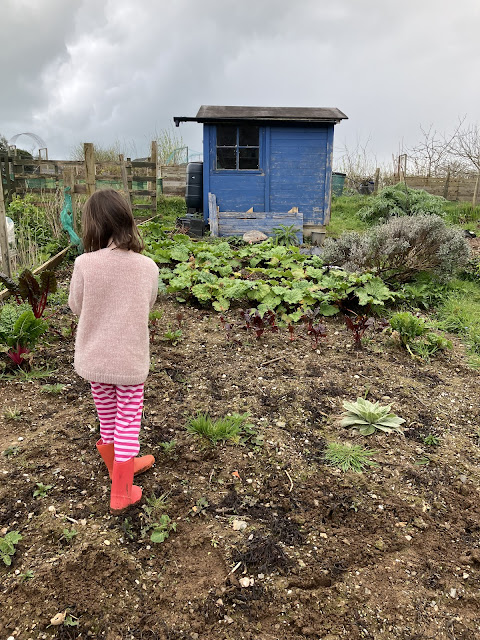
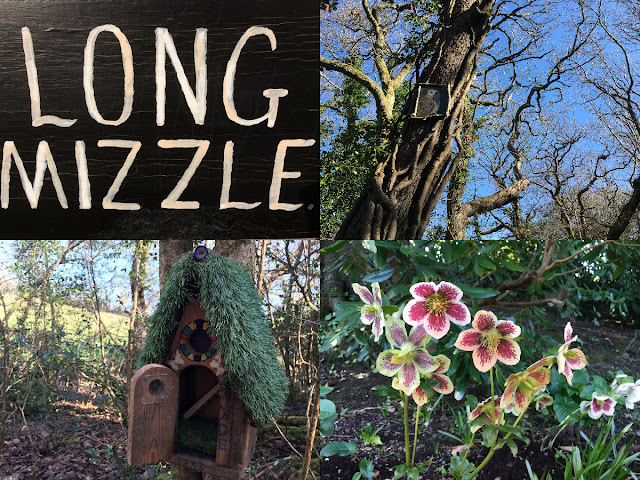

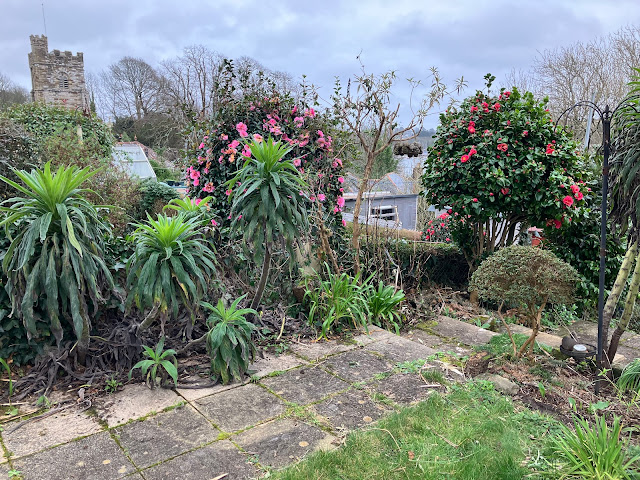
Hi Lulu, what a super post and story about the history of Daff and this particular grower. 2022 has been a very good year for daffs around Lincolnshire but your pics of these huge displays are something else. We have daff & tulip growers around Spalding in Lincs. and the display is wonderful, they are grown for the cut flower trade.
ReplyDeleteI had already decided to put lots more daffs into my garden this coming autumn so this has encouraged me to.make sure I do.
Can't believe the grower didnt rate Tete Te Tete, a lovely dwarf daff, I've had lots in pots for a few years now. Very convenient, they come out zs the buds start opening and after flowering they go back behind the Beech hedge to die down out of site.
Cracking photo's by the way, you've probably realised,my blog is more of a photo blog than much of the written word so I do appreciate good photography. That's enough from me, take care. 😊 🐕 🐢
Thank you David, super glad you liked the pictures. It was very kind of Adrian Scamp to welcome us and let us wander the field. I have a posh SLR camera somewhere but I've forgotten how to use it :0 These pictures were taken between a little cannon automatic and iPhone. You have inspired me to try harder with my photos! Enjoy the colourful Lincolnshire fields :) xXx
DeleteOh dear, I wasn't inferring your photo's weren't very good, just the opposite in fact. Your photo's are fine Lulu, remember, the best camera is the one you have with you. You might get more satisfaction using your "posh SLR camera" occasionally but more folk are using their smartphones these days. My phone isn't very smart and does well to send texts!!
DeleteDo you know, I really like the colours on my iPhone. I really resisted getting a Smart phone (I work in technology, so actually enjoy a break from it!) but it is super handy to have. I would like to reacquaint myself with our SLR camera though- an old friend & I used to go off on industrial photography adventures which were good fun. Hmm, the pub breaks may have helped too ;) x
DeleteHello Lulu what a great post with loads of pics I love daffodils and would enjoy a visit to those fields. The scamp family must work hard to produce so much beauty.
ReplyDeleteThanks Betty love, it was a real treat! Scamps is a small family business, but yes, a big field, thousands of daffodils to take care of and hard work for sure xXx
DeleteWow oh wow. Who needs to visit Holland when you can go and visit bulb fields like that. I'm more than a little bit green with envy. You take such clear photo's too so I can really see the stunning detail.
ReplyDeleteI know Cherie! All we need now are some Stroopwafels!!! I have a steady hand when I stay off the Shandygaff ;) xXx
DeleteWhat beauties, always special to see flowers en masse, especially the likes of daffs. Love your photos, there's something special about daffodils, symbolic of better times to come or new beginnings. All good wishes.
ReplyDeleteIt was such a joy to walk through, so uplifting. Glad you liked the pictures Mike :) xXx
DeleteAnd I thought I'd seen an unusual number of Daffs in the Beguinage when we were in Bruges! Those fields are really something else, and must have been an absolute joy to behold. The number of varieties is mind baffling as well and I had absolutely no idea the ubiquitous Tête-à-Tête' originated from your part of the world!
ReplyDeleteDove Cottage's garden definitely needs more Daffs too, and thanks to your tip I now know not to plant my bulbs too shallowly! xxx
I enjoyed your Beguinage daffs Ann and shall be back for Bruges Part 3! I am now eyeballing patches of ground for my autumn daffodil order ;) xXx
DeleteDear Lulu
ReplyDeleteStunningly beautiful daffodils - sunny and happy flowers. I love to see them. I am a big fan of Tete a Tete which looks great in the borders but just perfect in pots. I need more daffs for next Spring!
Best wishes and happy gardening
Ellie
A very happy field on that sunny day. It would also look fabulous with a dark grey storm sky. I am becoming just a little obsessed with pots of miniature daffodils :0 Happy gardening Ellie xXx
DeleteI had no idea there were so many varieties of daffodil, now you are making me want to have more than the one variety that I have in my garden. I love that the bulbs are toxic, that would explain why they never get eaten and my tulips always do. :(
ReplyDeleteSpoilt for choice 'eh! I am thinking about building a ratty proof wall of daffodils at the bottom of the garden! ;) xXx
DeleteOh they are beautiful flowers aren’t they? It’s been an education Lulu. I did hear one tit bit recently about not dead heading Daffs until they had drooped and withered and were well past their sell by date, at which point they also need a good seaweed feed, but I’m preaching to the choir here (and just showing off my limited knowledge in the subject). I love seeing those historical varieties. Stunning! xxx
ReplyDeleteWell you know I drink liquid seaweed for breakfast, lunch and tea Claire! ;) 'Feock', 'Firebrand' and the miniatures (I didn't do too well on capturing those on camera) were my favourites. Glad you liked 'em xXx
Deletedaffodil heaven!
ReplyDeletethank you for all this yellow gorgeousness - did not know most of the varieties - and thanx for sharing the knowledge about growing daffs.
....but i fear the giant voles (Arvicola amphibius) that live under my garden (we have an oxbow lake in the direct neighborhood) did´n got the memo about the poisoness...... had a big lot of narcissus poeticus and most of them disappeared over the years.
xxxxx
Thanks Beate :) Pesky Giant Voles! They must have steel stomachs!!! What a shame, poeticus are so incredibly pretty. I would be calling in Wallace and Gromit's Anti Pesto services ;) xXX
DeleteWow - what a spectacle!
ReplyDeleteIn days of yore when I did my RHS level 2 thingy I learnt to do the twin scaling thang - forgotten all about that ... so that lesson was not wasted then was it haha
I must admit not being a fan of the daffodil - however I do appreciate their charm and can see why so many folk love them. I believe despite their toxicity that there is a potential link for use in cancerous cell treatment x
Oooh, twin scaling at Level 2, that's hard core Kate! I don't think they do that until Level 3 now, but the RHS is shaking up their syllabus again soon. Interesting about the cancer treatment. I read something about daffodils being used for slowing down Alzheimer's too xXx
DeleteGoodness, Lulu, what an equally beautiful and informative post which I really enjoyed. The daffs are really beautiful!!
ReplyDeleteThanks Kezzie m' luverly. Glad you enjoyed xXx
DeleteWhat beautiful daffs, Lulu. I didn't know the Romans brought them over, every day's a school day! xxx
ReplyDeleteThanks Vix love :) There's some dispute at to what the Romans actually used daffodils for, but yes, it seems that they did cultivate them xXx
DeleteBeautiful photos and I will resist deadheading my daffs now!!
ReplyDeleteThanks Jane :) Depends what type you have!? Mind you, there doesn't seem to be any massive detrimental effect for not deadheading the ones you are supposed to :0 :0 :0 xXx
DeleteWhat beautiful daffodil photos! X
ReplyDeleteThank you Jess :) (not in shot - but I dressed like a daffodil, in yellow) xXx
DeleteRow upon row of beautiful daffodils. And now I have just realised I don't have a single one in my garden. I will rectify that next season. X
ReplyDeleteThank you Jules :) It's like visiting a new sweet shop - so many to choose from :0 xXx
Deletevery interesting, Lulu - I've heard about leaving them for bulbs, but this has filled in all the gaps - plus wonderful pics. What a fascinating day out! XX
ReplyDeleteThanks Sue - I always presumed the left ones were for lack of pickers (which I know happened during lockdown), but yes, it seems there is a secret life to the daffodil bulb! :) xXx
Delete